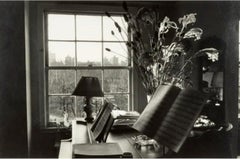Maria Frank Abrams
Recent Sales
1970s American Modern Black and White Photography
Silver Gelatin
Lee Friedlander for sale on 1stDibs
Lee Friedlander is best known for his street photographs that came to define a new style of documentary photography in the 1960s. He was equally committed to his Nudes series which he photographed over twelve years, beginning in the late 1970s. While the nude is the most classical of subjects, Friedlander’s depictions are anything but, presenting us with figures not from the canon of art history but contemporary culture. These women are not idealized nor glamorized but are the real bodies of everyday people. Indeed, after finding models through his network of friends, photographers and even ad postings, he visited them at their homes and photographed them in their beds, among their possessions. This heightened their sense of comfort and ultimately the viewers’ sense of intimacy with the subjects. One such model was Madonna, who posed for Friedlander from 1979–80, just a few years before the release of her first album in 1983. At the time, Madonna was a dancer in New York City, struggling to make ends meet through modeling and small roles in low-budget films. It is believed that she was paid $25 for the sittings. As her fame skyrocketed over the years, these images remain emblematic of her early career, before she would hone the public image for which she is known.
Finding the Right black-white-photography for You
There’s a lot to love about black and white photography.
The unique and timeless quality of a black and white photograph accentuates any room. Some might argue that we’re naturally drawn to color photography because it’s the world we know best. This is a shared belief, particularly in the era of camera-phone photography, editing apps and the frenetic immediacy of sharing photos on social media. But when we look at black and white photography, we experience deep, rich shadows and tonal properties in a way that transfixes us. Composition and textures are crisp and engaging. We’re immediately drawn to the subjects of vintage street photography and continue to feel the emotional impact of decades-old photojournalism. The silhouettes of mountains in black and white landscape photography are particularly pronounced, while portrait photography and the skylines of urban cityscapes come to life in monochrome prints.
When decorating with fine photography, keep in mind that some color photographs may not be suitable for every space. However, you can be more daring with black and white photos. The gray tones are classic, sophisticated and generally introduce elegance to any corner of your home, which renders black and white prints amazingly versatile.
Black and white photography adapts to its surroundings like a chameleon might. A single large-scale black and white photograph above the sofa in your living room is going to work with any furniture style, and as some homeowners and designers today are working to introduce more muted tones and neutral palettes to dining rooms and bedrooms, the integration of black and white photography — a hallmark of minimalist decor — is a particularly natural choice for such a setting.
Another advantage to bringing black and white photography into your home is that you can style walls and add depth and character without worrying about disrupting an existing color scheme. Black and white photographs actually harmonize well with accent colors such as yellow, red and green. Your provocative Memphis Group lighting and bold Pierre Paulin seating will pair nicely with the black and white fine nude photography you’ve curated over the years.
Black and white photography also complements a variety of other art. Black and white photos pair well with drawings and etchings in monochromatic hues. They can also form part of specific color schemes. For example, you can place black and white prints in colored picture frames for a pop of color. And while there are no hard and fast rules, it’s best to keep black and white prints separate from color photographs. Color prints stand out in a room more than black and white prints do. Pairing them may detract attention from your black and white photography. Instead, dedicate separate walls or spaces to each.
Once you’ve selected the photography that best fits your space, you’ll need to decide how to hang the images. If you want to hang multiple photos, it’s essential to know how to arrange wall art. A proper arrangement can significantly enhance a living space.
On 1stDibs, explore a vast collection of compelling black and white photography by artists such as Mark Shaw, Jack Mitchell (a photographer you should know), Berenice Abbott and David Yarrow.
